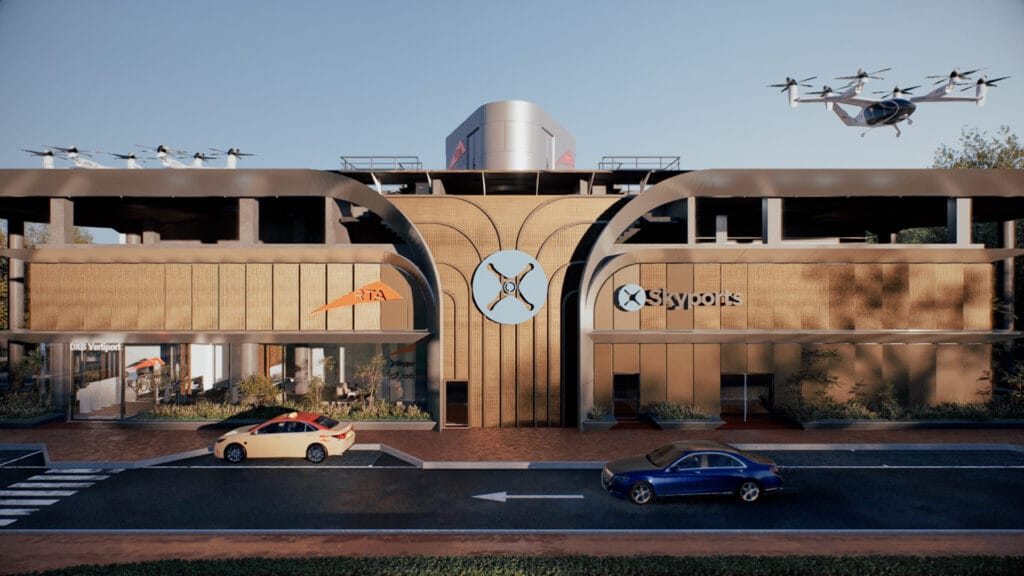By Shanil Rupesinghe, Operations Planning Manager, Skyports Infrastructure.
Introduction
Skyports Infrastructure (Skyports) is a global leader in ground infrastructure for electric vertical take-off and landing (eVTOL) aircraft operations. The company designs, builds, and operates networks of vertiports in major markets worldwide. Vertiports are structures used for the landing, take-off, and movement of eVTOLs. Skyports’ leadership in this space is underscored by its strategic partnerships with various eVTOL Original Equipment Manufacturers (OEM) and operators, including Archer, Beta, Joby Aviation, Vertical Aerospace, and Wisk. The company has secured significant investment, including a substantial equity investment from ACS Group, one of the world’s foremost infrastructure and construction companies.
Skyports has formed formal agreements in multiple regions to develop networks of vertiports that support the launch of commercial air taxi services. An example of this is the collaboration with Joby Aviation and Dubai’s Roads and Transport Authority (RTA) to establish a vertiport network in Dubai, with the goal of launching the world’s first commercial eVTOL air taxi services by 2026.
As Skyports executes on its network development plans, the company is moving beyond the initial Concept of Operations (ConOps) that shaped its early operations planning towards a detailed vertiport operations plan that has the company’s operational priorities of safety, efficiency, operator success, and passenger experience at its core.
Purpose and scope of white paper
The purpose of this paper is to outline how Skyports is planning to manage the complexities of eVTOL operations across a network of vertiports by utilising a remote Operations Control Centre (OCC) as a key infrastructure asset. The OCC is designed to optimise operational workflows, streamline communications, and maintain comprehensive and robust oversight of all vertiport activities, all while aligning with Skyports’ core operational planning priorities.
Skyports operations planning priorities
Operational priorities chart the course for achieving Skyports’ goals for the launch of commercial eVTOL aircraft operations. They also provide clear direction for other supporting functions, specifically IT, Product, and Vertiport Planning. The company’s four operational priorities are set out below.
Safety: Safety is our top priority, driving every decision and action to safeguard our people, operations, and stakeholders.
Efficiency: Efficiency is at the core of our operations; we simplify processes, maximise asset stewardship and ensure every function is seamlessly integrated.
Operator success: Our success is linked to the success of our eVTOL operators, achieved through strong collaboration, seamless support, and readiness for future flight operations.
Passenger experience: Create a future-ready, digital, zero-wait and contactless in-terminal passenger experience.

Planning for the remote OCC
The Operational Control Centre (OCC) is a centralised hub from which staff will monitor and coordinate operations across a network of vertiports managing the exchange of information with onsite staff to facilitate safe and efficient operations.
The OCC may be located within one of the Skyports vertiport or at an off-site location. Its location depends on key factors such as proximity to operations, access to reliable and robust communication and data infrastructure, ease of access for staff and logistical support, and scalability to accommodate future growth.
The size of the OCC is informed by several factors, including regulatory requirements, size of operations, and use cases involved. Regulatory requirements may dictate space for certain critical functions such as security monitoring. Space for staff and equipment will likely increase based on the volume and frequency of eVTOL operations. Other secondary functions such as training or accommodating other operational stakeholders (e.g. eVTOL operators) will also play a role in determining the OCC’s overall footprint. In the Dubai context, due to the industry being in the early stages of commercialisation, the operation will initially involve low-frequency flights within a limited network. Consequently, the OCC will be staffed by minimal team of one to two personnel, who will efficiently manage the four planned facilities in the initial network phase.
Central to OCC operations is the Vertiport Operations Dashboard (VOD). The VOD consolidates data from situational awareness tools (e.g., CCTV, ADS-B, and weather monitoring), communication systems (e.g., two-way radios), and resource management and scheduling systems (e.g., stand management) to provide actionable insights, enabling staff to assess operational status and make informed decisions quickly.
The next section outlines key functions that the OCC performs.
Flight monitoring
The OCC will leverage the Automatic Dependent Surveillance-Broadcast (ADS-B) system to monitor aircraft movements within the vertiport’s airspace and on the ground in real-time. OCC staff will monitor arrivals, departures and communications on the aerodrome frequency, ensuring timely coordination and safe ground operations. By monitoring aircraft within the vertiport’s airspace as well as ground movements, the OCC maintains situational awareness and can quickly identify and respond to potential issues.
Communication
The OCC’s role in communication is critical to maintaining safe operations. By centralising communication, the OCC directs the flow of information to facilitate timely responses and operational continuity. The OCC acts as the Aerodrome Ground Control Service (AGCS), managing the aerodrome’s published frequency during all operational hours. This communication channel supports effective coordination across the network by allowing the OCC, on-site vertiport staff, and pilots to share critical information, such as weather updates or alerts (e.g., birds near the landing area) detected by vertiport staff.
Emergency response
In the event of an emergency, the OCC serves as the central command. It is from the OCC that responses are coordinated and deployed. The OCC manages communication with external agencies, directs emergency procedures, and activates site-specific emergency response plans in coordination with the vertiport team on-site. These plans contain information and describe critical actions, such as emergency contact information, evacuation procedures, and coordination with relevant authorities. By acting as the unified command in crisis situations, the OCC facilitates efficient resource deployment and effective coordination with emergency services.
Weather monitoring
Each vertiport is equipped with advanced weather-sensing equipment that provides accurate, near real-time data at regular intervals during operational hours. The OCC monitors weather inputs alongside additional meteorological data, issuing alerts or suspending operations when necessary to ensure aircraft and ground safety. Severe weather conditions may prompt the OCC to restrict access to a vertiport or adjust operational plans to prevent disruptions. This ensures that weather-related risks are minimised and managed effectively.
Stand management
The OCC handles all aircraft stand bookings and allocations through Skyports’ proprietary Resource Management and Scheduling System (RMSS), ensuring efficient stand usage across the entire vertiport network. The RMSS allows dynamic and scheduled slot bookings, supporting both single-site and multi-site eVTOL operations. By centralising stand management, the OCC promotes a smooth flow of operations, eliminates stand conflicts, and maximises the efficient use of available resources.
Facilities systems monitoring
The OCC oversees the operation, maintenance, and monitoring of all physical infrastructure at the vertiport. This includes the management of utilities, safety systems, and performance tracking to ensure the vertiport remains fully functional. Through continuous monitoring of infrastructure and facilities, the OCC ensures that all systems function efficiently and comply with regulatory and safety standards. This proactive approach minimises the risk of operational disruptions that could affect the passenger experience. Table 1 below highlights how OCC functions align with and enhance the company’s operational priorities and value propositions.
Table 1: OCC functions and operational priorities

Benefits of an OCC
Improved communication
The remote OCC acts as a central communication hub to provide all vertiports in the network with timely and consistent operational updates. This not only enhances coordination but also reduces chances of miscommunication, ensuring that all teams remain aligned and responsive to real-time operational updates.
Standardised operating procedures (SOP)
OCC will apply Skyports SOPs across all vertiports within the network to ensure operational efficiency and reduce the risk of errors. Training, regular reporting and transparent communication through the OCC will be integral to this process, helping to swiftly identify and address any deviations from these procedures, thus supporting smooth and reliable operations.
Annual cost saving
Centralising network operations will reduce cost substantially by reducing the need such network coordination staff and equipment at each of the vertiport. In Skyports Dubai OCC, centralised operations for the four vertiport network can potentially result in up to 75% savings on staffing and equipment. Across a ten vertiport network, these savings could increase to up to 90% savings.
Establishing a remote OCC
To maximise the effectiveness of the OCC in supporting the expanding network, Skyports will adopt a phased approach to establishing a remote OCC. The example below illustrates one of several options currently under evaluation by Skyports.
Phase 1: Initial setup at the first vertiport: The OCC will initially be situated within the first vertiport (DXB), enabling direct oversight of early operations. This on-site presence will allow Skyports staff to closely monitor activities, gather critical data, and fine-tune operational processes for optimal performance.
Phase 2: Begin planning before the launch of the second vertiport: As preparations for the second vertiport commence, a centralised remote OCC will be established to streamline operations across all sites, ensuring efficiency and avoiding duplication of roles and functions.
Phase 3: Full functionality before the third vertiport: The OCC will be fully operational before the third vertiport launches, ensuring all sites are integrated into a unified management system. This phase will support seamless expansion and coordination across the entire network.

Challenges with establishing remote OCC
The establishment of a remote OCC requires navigating several technical and operational hurdles to ensure it functions effectively as the central command hub. Outlined below are the key foundational components of a remote OCC and associated challenges and mitigating actions.
Challenges to operational readiness:
Ensuring timely and accurate sharing of information
Challenge: Skyports will deploy a Vertiport Operations Dashboard (VOD) as the OCC’s centralised network monitoring platform, ensuring staff have a comprehensive, real-time overview of network activities and operations. One potential risk presented by an OCC is that staff may encounter challenges in simultaneously processing the operational status of various vertiport elements.
Mitigation: The VOD mitigates these challenges through the integration of multiple data feeds in one place, designed with user experience and operational requirement in mind. This enables staff to continuously monitor and assess site conditions across all vertiports. The VOD enhances situational awareness, streamlines decision-making, and supports swift and accurate operational responses.
Standardising operational procedures across sites
Challenge: Establishing standardised operational procedures across all vertiport sites that varies in layout, size, and elevation could potentially pose coordination challenges – particularly around procedural consistency.
Mitigation: To address these challenges, training will prioritise staff thorough understanding and adhere to correct procedures, and access to the latest site information whenever staff need it. This approach enables staff to quickly retrieve relevant details and apply their training effectively, reinforcing adherence to standardised procedures across all sites.
Coordinating remote emergency response plans
Challenge: In remote settings, OCC staff will lack physical access to incident sites which, if not addresses, could impact emergency response timing and coordinating.
Mitigation: Standardising response plans to the fullest extent possible – accounting for site specific variations – is essential for effective incident management. Skyports will develop comprehensive site-specific procedures to address various situations, such as aircraft incidents, medical emergencies and equipment malfunction. These protocols will be thorough, detailing critical emergency contacts, coordination steps with relevant authorities and other essential information. Roles and responsibilities for both OCC operators and on-site personnel will be clearly defined to ensure a swift and organised response.
IT infrastructure challenges
Network connectivity
Challenge: High-speed, reliable, and secure network connectivity is essential for real-time communication between the OCC, eVTOL operators, and other operational partners ensuring safe and efficient vertiport operations.
Mitigation: To address challenges such as latency and bandwidth limitations that could affect the timely distribution of critical information, Skyports employs Virtual FortiGate Firewalls and Fortinet SD-WAN, enabling robust performance and seamless connectivity to vertiports with no need for manual VPN setups or additional services.
Cloud infrastructure
Challenge: Cloud infrastructure and data storage are required for real-time data processing, monitoring, disaster recovery, and system redundancy. The main challenge is ensuring compliance with national regulations and managing cloud security risks.
Mitigation: Skyports addresses this risk through a cloud governance framework focused on security and compliance, supported by local policies and processes that define responsibilities, procedures, and controls to protect cloud-based assets, ensure data privacy, and meet regulatory standards.
Cybersecurity
Challenge: Skyports recognises that protecting sensitive data and systems against cyber threats such as unauthorised access, data breaches and compliance violations, is essential for safe operations.
Mitigation: Skyports will enhance data protection and safeguard against cyber-attacks by implementing data encryption, multi-factor authentication, and stringent access controls. Leveraging Azure’s robust Identity and Access Management (IAM) capabilities, Skyports will define precise permissions, roles, and policies to govern user access. Skyports will also work with the Dubai Electronic Security Centre (DESC) to ensure compliance with national policy on information security.
Integration of third party systems
Real-time data integration
Challenge: To ensure safe and efficient operations, data feeds from multiple vertiport-based systems must seamlessly integrate into the Vertiport Operations Dashboard (VOD). Key data feeds include slot and booking information, CCTV footage, weather updates, and ADS-B flight monitoring data.
Mitigation: To ensure reliable decision-making, Skyports will consolidate multiple data streams into a single source of truth, minimising inconsistencies. Measures will also be implemented to reduce latency in data transmission, ensuring that operational decisions are based on up-to-date information. Robust data consistency checks will be employed to maintain high data quality, enabling accurate information sharing with external partners via APIs and other communication protocols.
Third party system hardware and software failure
Challenge: The OCC will rely on third party software and hardware for its systems and equipment, which may potentially delay response time during failure and occurrences.
Mitigation: The OCC will be equipped to manage the failure of critical system hardware or software (e.g., weather feeds, ADS-B feeds). Skyports will implement robust redundancy protocols, including backup systems and alternative data sources, to maintain continuous functionality during external system disruptions. Real-time monitoring and diagnostic tools will be deployed to swiftly detect, isolate, and address system issues, enabling rapid communication with third-party vendors for timely resolution. Clear contingency plans, supported by alternative workflows, will be established to minimise downtime and mitigate operational impact. By fostering strong partnerships with third-party providers and maintaining resilient failover systems, Skyports will effectively mitigate risks associated with external system failures, ensuring uninterrupted operational performance and long-term resilience.
OCC and future programs of work
While this white paper focuses on the remote OCC, it is just one of several initiatives that Skyports will deliver to support the successful launch of eVTOL operations. Future white papers will explore topics such as operations capacity modelling, multi-site/multi-operator operations, and preparation for IFR operations, that will further enhance our operational framework, ensuring Skyports remains at the forefront of eVTOL infrastructure and service delivery.
